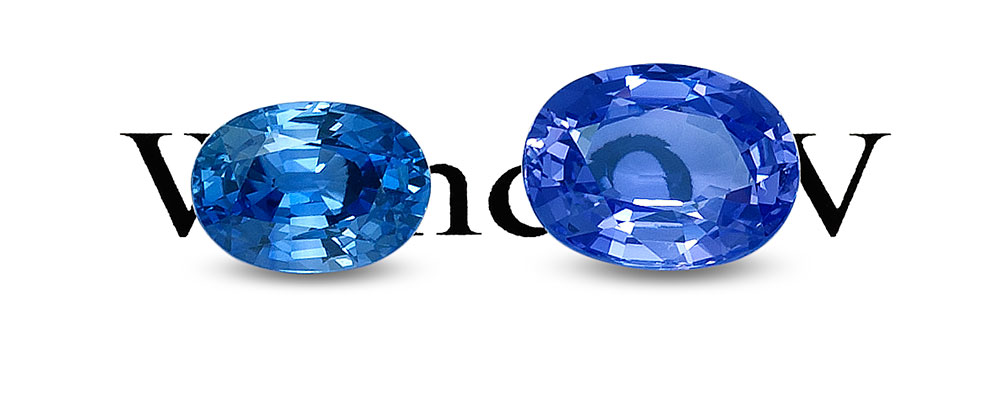A discussion of brilliance, windows and extinction as they relate to the face-up appearance of colored gemstones. Diagrams demonstrate that extinction is largely a function of cut.
Gemologists have long recognized that the beauty of colored gemstones results from a complex interaction of three basic features: color, clarity and cut. Of these three, perhaps the most neglected and misunderstood is cut. The advent of colored stone grading systems in the past ten years, however, has brought about a reexamination of the exact role that cutting plays in the beauty of gemstones.
The stated purpose of a diamond's cutting style is largely threefold: to create, in a symmetrically pleasing but durable manner, a maximum combination of brilliance (return of light), dispersion ('fire'), and scintillation (a twinkling effect). Brilliance is provided mainly by the pavilion facets, which catch the light rays and throw them back to the eye; while dispersion results from the prism effect of the crown facets, which split white light into its spectral components; scintillation is achieved by breaking large facets up into smaller ones (during cutting) to create a twinkling effect when either the eye, the light or the stone is moved.
Unlike diamond, most colored stones possess little dispersive power; thus the cutting style of a colored gem is designed only for brilliance and scintillation, largely the former rather than the latter.
The most striking aspect of a colored stone's beauty is its color. It is this feature which the cut is intended to enhance. However, a faceted colored stone does not just display a single uniform color when viewed from above. Instead (aside from effects due to pleochroism and color zoning), it displays three varying shades of the hue. These three color variations result from three different phenomena: brilliance, windows and extinction. It is these phenomena which this article will discuss.
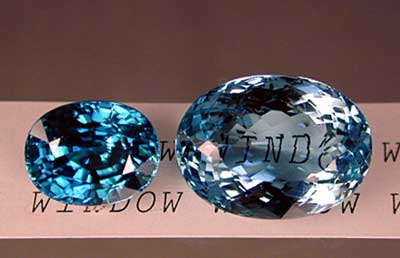 If a gem is cut too shallow, light will pass straight through, rather than returning to the eye as brilliance. This is termed a “window” (right). In well-cut gems, most light returns as brilliance (left). Brilliant areas are those showing bright reflections. Extinction is used to describe dark areas where little or no light returns to the eye. Photo by Wimon Manorotkul/Palagems.com.
If a gem is cut too shallow, light will pass straight through, rather than returning to the eye as brilliance. This is termed a “window” (right). In well-cut gems, most light returns as brilliance (left). Brilliant areas are those showing bright reflections. Extinction is used to describe dark areas where little or no light returns to the eye. Photo by Wimon Manorotkul/Palagems.com.
Virtually all books on gem cutting describe brilliance and windows and all grading systems do the same. Extinction. however, is entirely absent from cutting treatises (Vargas,1969, Sinkankas,1984), and discussions of grading (Patterson, 1982; GIA, 1983; AGMS, 1986) have only recently mentioned the term. Even where mentioned, however, a true understanding of the cause and significance of extinction is not found.
The first mention of extinction found by the author in the literature is that of Patterson (1982). He states the following :
Black extinction is an often misunderstood characteristic of colored stones where black is reflected back instead of color. Wrongly, extinction is ignored, called tone, or called dichroism. It is a characteristic most commonly observed in Thai rubies and in sapphires from most sources. It will involve entire facet faces. As the stone is manipulated when face-up, the amount of extinction will remain relatively the same. The effect is also observed in some emeralds, often in tourmalines, many of the garnets, including tsavorite, and some spinels. For years the trade has called such stones "Garnety." It has been my experience that garnets and spinels which exhibit extinction also exhibit extensive anomalous double refraction. The characteristic appears to be a polarizing effect. Basically, a gem quality stone is 100% color and has no extinction. As extinction increases, value goes down more rapidly at first and then more slowly as black becomes a large part of the color. Extinction is a nonlinear effect, almost as strongly so as modifier (saturation).
The colored stone grading course workbook of the Gemological Institute of America (GIA, 1983) defines extinction in similar vague terms:
Extinction is areas of darkness visible when the stone is judged for brilliance. It is caused by blackness in the stone and the proportion angles. Judge extinction as a percentage or as a fraction of the whole stone. View the stone while holding it both horizontally and vertically and assess the extinction in whatever position it is the least.
The American Gem Market System (AGMS) Network Grading Manual (1986) had this to add about extinction:
"Extinction," or "blackout" in gem materials is a phenomenon most apparent in dark tone stones, but which can be present in lighter tone material also. The effect can be reduced in the middle of the stone by "windowing" during cutting. Orientation of rough during cutting can either decrease or increase the effect, but cannot entirely eliminate it unless the stone is cut too shallow or with almost no BRILLIANCE. When grading extinction, the stone is held face up over a plain white background under diffused daylight lighting, and a judgment is made as to how much (what percentage) of the stone reflects back the true color of the gem and does not "black out." The visible surface of the stone represents 100%. When the stone is tilted slightly in any direction, any extinction present will appear to move from facet to facet. The percentage of the stone which is "extinct" usually remains constant, so an estimation can be made as to what percent of the total area is extinctive. Care should be taken not to confuse dark tone with extinction. Extinction is black, with none of the hue of the stone apparent.
It is clear from the above excerpts that, although extinction is definitely recognized as occurring, there is no clear understanding of the mechanism involved. To gain a feel for what extinction is and how it comes about we must examine the entire concept of brilliance, windows and extinction in gems.
As previously mentioned, brilliance refers to a return of light to the eye when a gem is viewed from above. The amount of brilliance that a gem displays if free of inclusions is mainly a function of two things: the angle of the pavilion facets and the stone's critical angle (which is inversely proportional to the refractive index of the stone). Because it is primarily the size and angles of the pavilion facets that are responsible for influencing these phenomena, only the pavilion is shown in the following illustrations.
Below is shown the path that light takes when it falls directly onto a stone with a refractive index (RI) of 1.5 and a pavilion angle of 43°, from above.
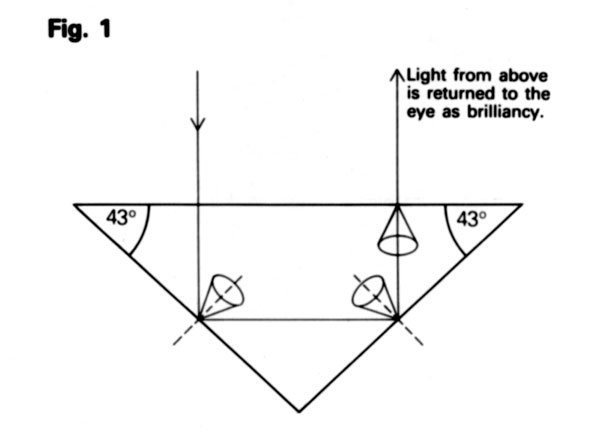 Light path for light falling directly on a gem from above, where the gem refractive index is 1.5 and the pavilion angle is 43°.
Light path for light falling directly on a gem from above, where the gem refractive index is 1.5 and the pavilion angle is 43°.
Gems with an RI of 1.5 will have a critical angle of 41.81° [arcsin(1/1.5), where 1.5 represents the RI of the gem]. As one can see from the above illustration, light striking the first pavilion facet is well outside of the stone's critical angle and so is totally (100%) internally reflected across to the/opposite side of the pavilion. Again it is outside the critical angle and so is totally internally reflected. At the third surface the light is within the critical angle. "Planned leakage" now occurs and the ray exits the stone back towards the eye. Facets which are cut at the proper angle to allow this to occur will thus display brightly colored reflections which are termed brilliance. Because the path length of the ray is much longer than if it were to just go straight up to the eye from the rear, in a colored gem the totally internally reflected rays will display a very rich color. Adding to this effect is the fact that almost 100% of the ray's intensity is returned to the eye due to the total internal reflection. Almost nothing is lost. As a result, facets where this occurs will show a much richer and more intense color than those not showing the effect. Because in a well cut stone, a large proportion of the face will show these intensely colored, specular reflections. the color seen on the brilliant facets is often referred to as the "true" color of the gem. A good judge of the quality of a gem's cutting is then given by estimating the percentage of the stone that shows these specular reflections (brilliance) in the face-up position. The higher the percentage, the higher the brilliance, and thus, the better the cutting quality.
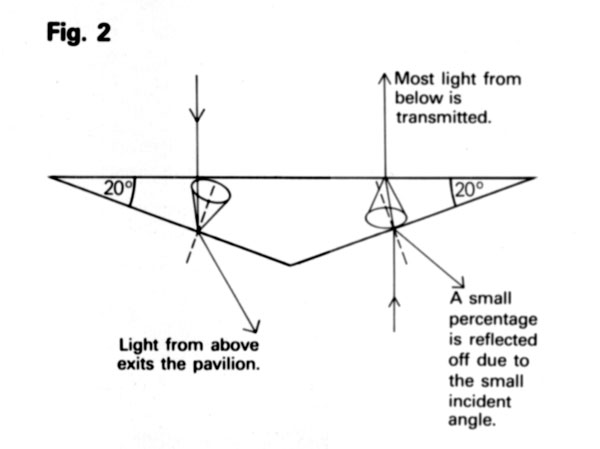 Light path for light falling directly on a gem from above, where the gem refractive index is 1.5 and the pavilion angle is 20°. Light from above exits the pavilion while light from below is transmitted.
Light path for light falling directly on a gem from above, where the gem refractive index is 1.5 and the pavilion angle is 20°. Light from above exits the pavilion while light from below is transmitted.
Figure 2 shows the same material (RI = 1.5), but this time cut with a pavilion angle of only 20°. Light falling directly from above strikes the pavilion within the critical angle and so exits as unplanned leakage, never to be seen again. Light coming from the rear strikes the air/gem interface and is partly reflected off and partly transmitted through the stone. The transmitted portion (8O%, these percentages are approximate only) is much greater than the reflected portion (20%) because the light hits the surface very close to the normal (angle of incidence = 20°). The lower the RI of the gem and the shallower the pavilion angle, the smaller the percentage of light that is lost from reflection, and vice versa.
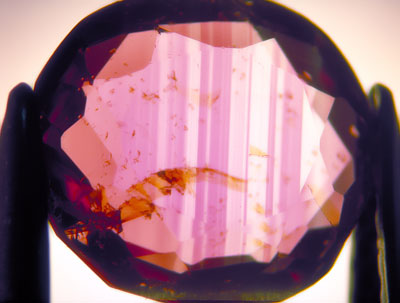 This Burmese ruby is cut so shallow that light passes straight through, revealing strong color zoning and yellow stains in feathers. In this stone, brilliance is almost entirely absent, with only a large central window and extinction near the edges being visible. Photo by the author.
This Burmese ruby is cut so shallow that light passes straight through, revealing strong color zoning and yellow stains in feathers. In this stone, brilliance is almost entirely absent, with only a large central window and extinction near the edges being visible. Photo by the author.
Even though some light is able to pass through the gem from the rear to the eye. these rays will be lackluster in color due to the very short paths involved. Thus. the color of the stone on "window" facets is insipid and dull.
Note: when light strikes any interface while going from a lower to a higher RI substance (such as from air to a gem), part of this ray will be refracted into the gem while part is reflected off the surface back into the air. The amount of light which enters the gem is related to two factors the angle of incidence and the RI of the gem (Actually related to the difference in RI between the gem and air. As the RI of air is constant at 1.00, it then depends solely on the RI of the gem.). The greater the angle of incidence and the higher the gem's RI, the greater the amount that is reflected back into the air, as shown in Figure 3 below.
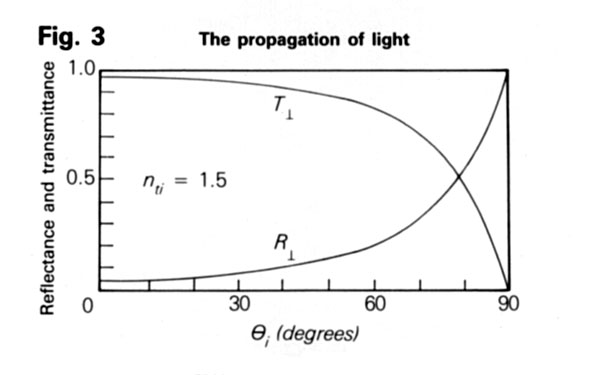 Graph showing how the amount of reflection increases at an air/gem interface as the angle of incidence increases.
Graph showing how the amount of reflection increases at an air/gem interface as the angle of incidence increases.
Now we will consider the path of light in a gem (RI = 1.50) whose pavilion angle is cut at an angle of 75°, much steeper than the ideal of 43°.
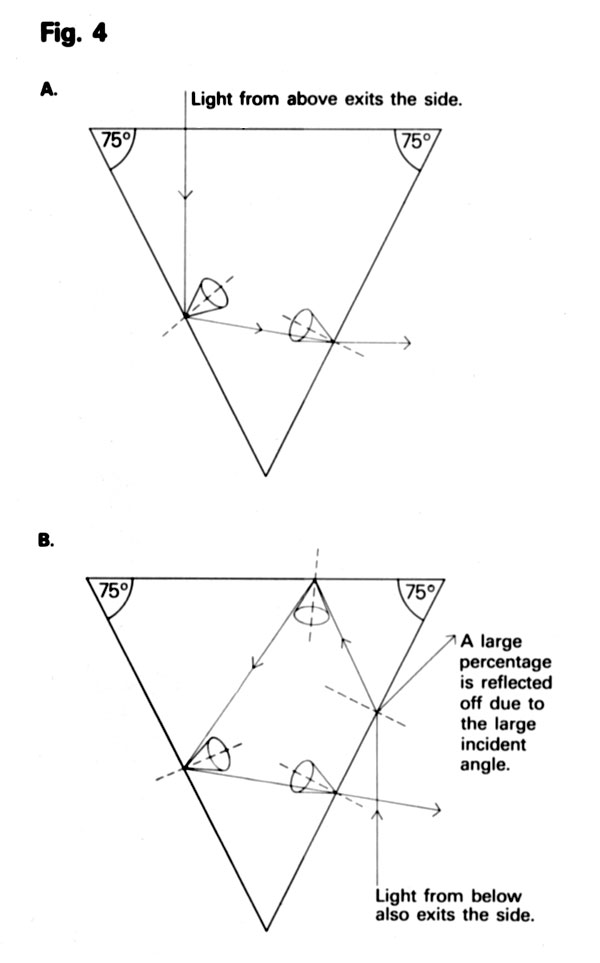 The path of light from above where the pavilion angle is 75°. Much of the light exits the side, while little light from below makes it through the gem.
The path of light from above where the pavilion angle is 75°. Much of the light exits the side, while little light from below makes it through the gem.
As one can see, light from above (4A) is totally internally reflected at the first pavilion facet, but on the opposite side (due to the steep pavilion angle) it falls within the critical angle and so is refracted out of the stone. For light coming from the rear (4B), due to the steep incident angle (again a result of the overly steep pavilion angle), a rather high percentage of the incident ray is reflected off at the air/gem interface. This means that even if the refracted portion manages to exit through the crown towards the eye, it will be reduced in intensity, giving the facet a dark appearance (extinction). In the example shown above, even this possibility is negated, as the ray strikes the crown at too shallow an angle and so is totally internally reflected back to the pavilion. Here it is within the critical angle and so is reflected out of the gem as unplanned leakage. Thus one can see that when pavilion facets are cut at too steep an angle, light from above exits the side of the pavilion as unplanned leakage. Furthermore. light striking the pavilion from the rear is reduced in intensity due to the steep incident angle. Depending on the pavilion angle, light from behind may manage to exit the crown, or it may reflect back off the table and re-exit the pavilion. Even when some rays do manage to exit the crown, they are reduced in intensity and are of lackluster color due to the short paths involved. As a result, pavilion facets cut at too steep an angle appear very dark; thus the term "extinction."
Observation has shown that extinction is present to a certain degree in all faceted gemstones, including diamond, no matter how well they are cut. Individual stones will posses varying degrees of extinction, as well. For simplicity's sake, the number of light paths shown above has been kept to a minimum, but in faceted gemstones light is actually coming from many different directions. As a result, facets within a stone will have different degrees of extinction, some appearing darker than others. In dark-toned gems (gems of low reflectance), the extinction may appear completely black, while in lighter stones it is merely dark. Gems which are heavily included, however, tend to display much less extinction. This is because the inclusions scatter the light in random directions, covering up this effect (which results from the symmetry of the facets). Such is the case with lai Thai ('Thai design,' in reference to the many wispy fingerprints which form patterns similar to those on Thai silk) rubies. as well as with silky Burmese rubies. It is interesting to note that one of the major differences between Thai and Burmese rubies is in reference to the extinction each displays. This was first noted by Ulrich Gühler in 1947. who wrote:
The colour of the Siamese ruby is inferior to that of the Burmese ruby. The colour tends to be purplish or even brownish and is generally too dark. A Siamese ruby inspected under natural or artificial light will show its colour only on those facets which are directly hit by the light. Those facets in the shade will appear almost black. A Burmese ruby will appear red throughout, even on those facets which are not directly exposed to the source of light.
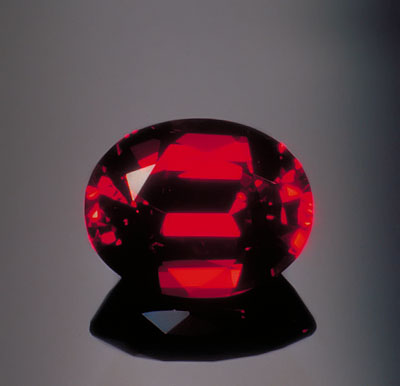 This well-cut Thai/Cambodian ruby shows a combination of both brilliance and extinction. Photo by the author.
This well-cut Thai/Cambodian ruby shows a combination of both brilliance and extinction. Photo by the author.
From the above excerpt it is clear that Gühler was talking about the greater amount of extinction of Thai rubies when compared with those from Burma. His observation was correct (and very astute, I might add), but his explanation was somewhat lacking. Extinction results from cutting. The strong fluorescence of Burmese rubies, however, tends to mask the effect. Thus the greater value of Burmese rubies in the market. It is interesting to note that, although the market tends to claim that poor color rubies, particularly those from Thailand, are too purple in color, such is not the case. The hue position of rubies actually varies very little from stone to stone. What is the difference, then, between the color of one ruby and another? Intensity. It is largely a difference of intensity (saturation), and to a lesser degree, tone (reflectance). In actual fact, the hue position of most Burmese rubies is more purple than their Thai counterparts. Why are the Burmese rubies more valuable then? It has to do with their fluorescence. The fluorescence of Burmese rubies tends to cover up the facets that would otherwise display extinction. This, coupled with the often high intensity of color, creates more beautiful stones. The importance of color intensity to the beauty of colored stones will be the subject of a future paper.
In addition to cutting and fluorescence, the number and types of inclusions present may also affect the extinction displayed by a stone. Heavily included stones, such as lai Thai rubies and silky Burmese rubies, often do not show clear extinction because the inclusions tend to scatter light in random directions (directions that it would not normally travel in). Thus the extinction is often not very distinct in moderate to heavily included stones.
Colored gemstones do not show only one of the above effects. Generally, the pavilion facets closest to the girdle are cut too steep while those at the culet are too shallow; often only those in between are cut at the proper angle. This results in three distinct zones: extinction near girdle, windows near the culet and brilliance in-between, as shown clearly in the step-cut pavilion below.
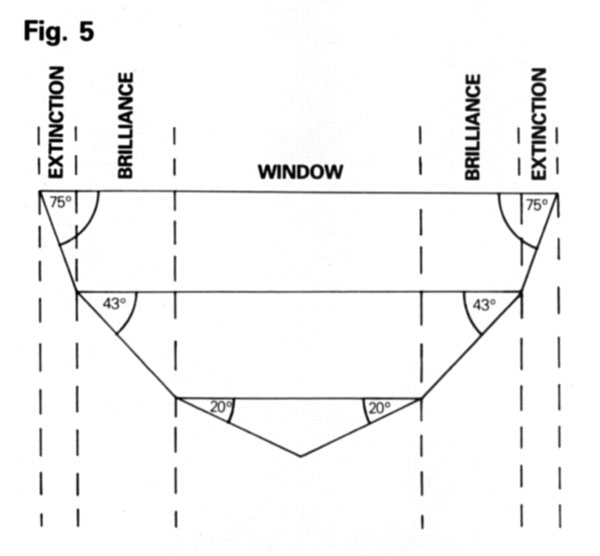 Zones of brilliance, windows and extinction in a faceted gem.
Zones of brilliance, windows and extinction in a faceted gem.
From the above discussion it is now clear that the three phenomena of brilliance, windows and extinction are each interrelated and arise mainly from cutting. Not every facet that shows brilliance, though, shows exactly the same color, nor do all of those that show extinction show the same depth of extinction. To simplify the above discussion, only a few light paths have been shown; however as light is actually coming from many different directions, facets throughout the stone will tend to show varying degrees of brilliance, windows and extinction.
In summary, the cause of the three phenomena of brilliance, windows and extinction can be traced back to the angles at which the facets of the stone were cut. In the grading of colored stones it is vital that all of the major factors which influence the appearance be understood and accurately described. Failure to describe the extent of such an important factor as extinction, or attributing it to the wrong cause, can only lead to problems in the final grade.

References
- AGMS (1986) Network Grading Manual. p. 15.
- Gemological Institute of America (1983) Colored Stone Grading Workbook. p. 41
- Gühler, Ulrich (19471 Studies of precious stones in Siam. Siam Science Bulletin, Vol. IV, No. 1, pp. 1–39
- Patterson, David A. (1982) Gemology and the gemstone buyer. In International Gemological Symposium – Proceedings 1982, pp. 519–527.
- Sinkankas, John (1984) Gem Cutting: A Lapidary's Manual. Third Edition, Van Nostrand Reinhold. New York, NY, 413 pp.
- Vargas, G. and Vargas, M. (1969) Faceting For Amateurs. Privately Published, Thermal, CA, 330 pp.
About the author
Richard W. Hughes is one of the world’s foremost experts on ruby and sapphire. The author of several books and over 170 articles, his writings and photographs have appeared in a diverse range of publications, and he has received numerous industry awards. Co-winner of the 2004 Edward J. Gübelin Most Valuable Article Award from Gems & Gemology magazine, the following year he was awarded a Richard T. Liddicoat Journalism Award from the American Gem Society. In 2010, he received the Antonio C. Bonanno Award for Excellence in Gemology from the Accredited Gemologists Association. The Association Française de Gemmologie (AFG) in 2013 named Richard as one of the Fifty most important figures that have shaped the history of gems since antiquity. In 2016, Richard was awarded a visiting professorship at Shanghai's Tongji University. 2017 saw the publication of Richard and his wife and daughter's Ruby & Sapphire • A Gemologist's Guide, arguably the most complete book ever published on a single gem species and the culmination of nearly four decades of work in gemology. In 2018, Richard was named Photographer of the Year by the Gem-A, recognizing his photo of a jade-trading market in China, while in 2020, he was elected to the board of directors of the Accredited Gemologists Association and was appointed to the editorial review board of Gems & Gemology and The Australian Gemmologist magazine. Richard's latest book, Jade • A Gemologist's Guide, was published in 2022.
Notes
This article was first published in Gemological Digest (1988, Vol. 2, No. 1 & 2, pp. 10–15).

